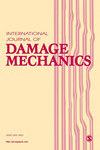Numerical simulation on hydraulic fracture propagation in laminated shale based on thermo-hydro-mechanical-damage coupling model
IF 4
2区 工程技术
Q2 MATERIALS SCIENCE, MULTIDISCIPLINARY
引用次数: 1
Abstract
The temperature of a deep shale reservoir may reach more than 100°C, and the effect of thermal shock on shale hydraulic fracturing has rarely not been considered in previous studies. Based on mesoscopic damage mechanics and the finite element method, a thermo-hydro-mechanical-damage (THMD) coupling model considering temperature, seepage, stress, and damage fields was constructed to investigate the effects of reservoir temperature, convective heat transfer coefficient (h), in-situ stress difference and bedding plane angle (αθ) on shale hydraulic fracturing. The results show that multiple hydraulic fractures (HFs) can occur under thermal shock and that HFs control the distribution of seepage, temperature, and stress fields. Reservoir temperature, in-situ stress difference and αθ are primary factors affecting hydraulic fracturing, whereas h is a secondary factor. When the reservoir temperature rises from 50°C to 150°C, the initiation and breakdown pressures decrease by 65.5% and 16.7%, respectively. HFs cross the bedding plane more easily, and fracture complexity is obviously enhanced. A higher h is favourable for slightly reducing the initiation and breakdown pressures, but it has little influence on the fracture complexity. Once the in-situ stress difference is low, there is a high fracture complexity, but HFs are more easily captured by bedding planes to limit the propagation of fracture height. When the in-situ stress difference is high, HFs are more likely to form bi-wing fractures. Whether αθ is too large or small, it is not conducive to improving the fracture complexity. In this study, when αθ is 30°, HFs and bedding planes intersect to form a fracture network. Essentially, thermal shock plays a key role in reducing the initiation pressure and forming multiple HFs during the fracturing process, and fracture propagation mainly depends on the injection pressure. The results can serve as reasonable suggestions for the optimization of shale hydraulic fracturing.基于热力-水力-机械损伤耦合模型的层状页岩水力裂缝扩展数值模拟
深层页岩储层的温度可能达到100°C以上,在以前的研究中很少没有考虑热冲击对页岩水力压裂的影响。基于细观损伤力学和有限元方法,建立了考虑温度场、渗流场、应力场和损伤场的热-水力-机械损伤(THMD)耦合模型,研究了储层温度、对流传热系数(h)、地应力差和层面角(αθ)对页岩水力压裂的影响。结果表明,在热冲击作用下,可发生多处水力裂缝,这些水力裂缝控制着渗流场、温度场和应力场的分布。储层温度、地应力差和αθ是影响水力压裂的主要因素,h是次要因素。当储层温度从50°C上升到150°C时,起始压力和击穿压力分别下降65.5%和16.7%。HFs更容易穿过层面,断裂复杂性明显增强。较高的h有利于略微降低起始压力和击穿压力,但对裂缝复杂性影响不大。一旦地应力差较低,就存在较高的裂缝复杂性,但HFs更容易被层面捕获,从而限制裂缝高度的扩展。当地应力差高时,HFs更有可能形成双翼裂缝。无论αθ过大还是过小,都不利于提高裂缝的复杂性。在本研究中,当αθ为30°时,HFs和层面相交形成裂缝网络。从本质上讲,在压裂过程中,热冲击在降低起始压力和形成多个HF方面起着关键作用,而裂缝的扩展主要取决于注入压力。研究结果可为优化页岩水力压裂工艺提供合理建议。
本文章由计算机程序翻译,如有差异,请以英文原文为准。
求助全文
约1分钟内获得全文
求助全文
来源期刊

International Journal of Damage Mechanics
工程技术-材料科学:综合
CiteScore
8.70
自引率
26.20%
发文量
48
审稿时长
5.4 months
期刊介绍:
Featuring original, peer-reviewed papers by leading specialists from around the world, the International Journal of Damage Mechanics covers new developments in the science and engineering of fracture and damage mechanics.
Devoted to the prompt publication of original papers reporting the results of experimental or theoretical work on any aspect of research in the mechanics of fracture and damage assessment, the journal provides an effective mechanism to disseminate information not only within the research community but also between the reseach laboratory and industrial design department.
The journal also promotes and contributes to development of the concept of damage mechanics. This journal is a member of the Committee on Publication Ethics (COPE).
 求助内容:
求助内容: 应助结果提醒方式:
应助结果提醒方式:


